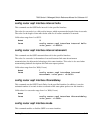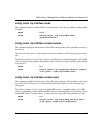
7000 Series L3 Managed Switch Reference Manual for Software v2.0
8-18 Routing Commands
indicates that the router is not eligible to become the designated
router on this network.
State The types are:
Down- initial state of the neighbor conversation - no recent infor-
mation has been received from the neighbor.
Attempt - no recent information has been received from the
neighbor but a more concerted effort should be made to contact
the neighbor.
Init - an Hello packet has recently been seen from the neighbor,
but bi-directional communication has not yet been established.
2 way - communication between the two routers is bi-directional.
Exchange start - the first step in creating an adjacency between
the two neighboring routers, the goal is to decide which router is
the master and to decide upon the initial DD sequence number.
Exchange - the router is describing its entire link state database
by sending Database Description packets to the neighbor.
Loading - Link State Request packets are sent to the neighbor
asking for the more recent LSAs that have been discovered (but
not yet received) in the Exchange state.
Full - the neighboring routers are fully adjacent and they will now
appear in router-LSAs and network-LSAs.
Events The number of times this neighbor relationship has changed state,
or an error has occurred.
Permanence This variable displays the status of the entry, either dynamic or
permanent. This refers to how the neighbor became known.
Hellos Suppressed This indicates whether Hellos are being suppressed to the neigh-
bor. The types are enabled and disabled.
Retransmission
Queue Length
Is an integer representing the current length of the retransmission
queue of the specified neighbor router Id of the specified inter-
face.
show router ospf neighbor table
This command displays the OSPF neighbor table list. When a particular neighbor ID is specified,
detailed information about a neighbor is given. The information below will only be displayed if
OSPF is enabled.
Format show router ospf neighbor table <slot.port>


















